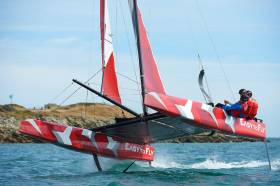Displaying items by tag: Guillaume Verdier
New Volvo Ocean Race Design Is Taking Shape
#VOR - Just over three months ago, the Volvo Ocean Race unveiled the new generation of boats for the next decade and beyond, as previously reported on Afloat.ie.
In its answer to the big question ‘monohull or multihull?’, the VOR opted for both: a one-design foil-assisted 60ft monohull for the ocean legs, and a one-design 32-50ft foiling catamaran for use inshore at the stopovers.
Now, with the 2017-18 edition already apace following a thrilling Leg Zero, work on the two new boats has been moving fast in the background, as the VOR website reports.
Last week, the first mock up of the Guillaume Verdier-designed offshore monohull was revealed at the Boatyard in Lisbon.
“We contacted several designers and asked them to submit their ideas for both a complete stand-alone Volvo Ocean Race boat, or with the potential to convert to an IMOCA boat,” said Boatyard head Nick Bice.
“All the designers that we invited to present were very strong, it wasn’t clear cut – we had some pretty serious soul-searching to decide what we wanted to do. I went to New Zealand and spent a day with Guillaume to get to know him, and we decided he was our man.”
Verdier is best known as a designer for the foiling 2016 Vendée Globe boats, and for the 35th America’s Cup winners Emirates Team New Zealand.
“We’ve created the Volvo Ocean Race Design Team as a collaboration, getting the best input from everywhere,” said Bice. “It’s going to be a very cool boat; imagine coming into the finish, in a harbour in 20 knots of breeze and you are going to see this thing fully airborne, foiling, at 35 to 40 knots.”
Verdier's team is already working hard on the hull lines. The design has developed in a way that will enable IMOCA 60 compatibility, making it convertible for events like the Vendée Globe.
And they’ve got not time to lose, with Bice emphasising the “critical path” till the scheduled launch in June 2019.
“Working all the way back from that, we need to start machining the moulds in September. Then we need to start laminating the first boat at the end of February, early March next year,” says Bice, who adds that Persico Marine in Italy is the lead contractor for the ambitious project.
As for the inshore foiling multihull, the tender period closed on Monday 31 July with 16 proposals received. Now Bice, as chief technical development officer, and his team must make their decision in view to an announcement during pre-race events in Alicante this October.
The VOR website has more on the story HERE.
New Foiling Catamaran Is ‘Easy To Fly’
#Foiling - Orders are flying in for a new design foiling catamaran, according to its French makers.
Easy to Fly is the brainchild of solo sailor Jean-Pierre Dick, who placed fourth in the most recent Vendée Globe, and Guillaume Verdier, designer behind the new foiling One Design monohull chosen for future editions of the Volvo Ocean Race.
The 26ft multihull is designed to fly safely from a wind speed of 8 knots with three people on board — and is likely to be a future fixture on a French sailing scene that’s fully embraced foilingfoiling as a discipline.
Launched in September 2016, sales for Easy to Fly are up to six across Europe — including one to England, to the team behind the Open7.50 Cool Runnings, who will take delivery of their boat next week.
Foiling is in right now. And with Olympic hero Annalise Murphy leading the Irish charge in the relatively new class, there’s never been a better time to get on board and get flying on foils.
Visit www.EasyToFly.fr for more.

























































